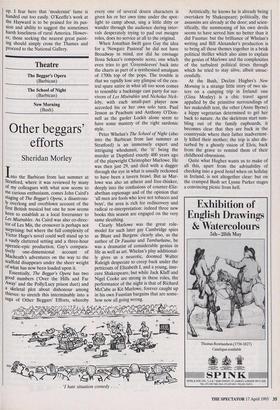Exhibitions
Georgia O'Keeffe (Hayward Gallery, till 27 June)
Great misjudgment
Giles Auty
Were one to have no knowledge of art other than from this century, it might be easy to imagine the work of certain artists to be more significant than it is. Thus the particular problem for me in going to see the substantial exhibition of Georgia O'Keeffe's work at the Hayward is that I had spent much of the previous week in the Veneto.
Had I not been looking at paintings by Pisanello, Mantegna, Veronese, Tintoretto, Moroni and umpteen others ' in the Castelvecchio at Verona or Giovanni Belli- ni's 'Baptism of Christ', say, in Santa Coro- na at Vicenza, the paintings of O'Keeffe might have seemed altogether more tolera- ble and worthy. But a large dose of incom- parable painting and architecture in Asolo, Mantua, Bassano del Grappa, Treviso and the places mentioned already, to say noth- ing of the sight of cherry orchards in flower on the approaches to Lake Garda while snow lay thick still on the Dolomites, can- not but sway one's perspective. If the Unit- ed States could lay claim to an equivalent even of some small fraction of the art his- torical treasures which exist in the Veneto, I imagine that great nation might feel less need to urge the case of American painters of this century such as O'Keeffe whose tal- ent, on the evidence of this first major showing of her work in Britain at least, is a minor one at best.
In remarking on this I do not wish espe- cially to affront the chauvinist sensibilities of the American nation, nor even to raise the hackles of armies of feminists for whom O'Keeffe will have some special, totemic significance no doubt. All I am stating is an artistic fact which can be apprehended by simple use of eyes and intelligence though both are employed very seldom in modern art criticism, of course.
O'Keeffe was born on a farm in Wiscon- sin in 1887 and failed by only 18 months to become a centenarian. The title of the cur- rent exhibition 'Georgia O'Keeffe: Ameri- can and Modern' emphasises the experimental and abstract nature of a good deal of her early work. Much of this looks pretty feeble and amateurish — an aspect not aided by some of the curious framing employed — although possibly no worse in this respect than contemporary essays in abstraction, say, by the vaunted British artist Vanessa Bell, I imagine what we are supposed to think is that O'Keeffe was wonderfully daring to have been doing such work at the particular time, however incon- 'View from my Studio, New Mexico, by Georgia O'Keeffe sequential it may look today.
Modern art criticism does not concern itself too much with appearances. If it did, I could recommend a woman artist from Ireland whose experimental paintings made at precisely the same juncture — roughly 1915-25 — are certainly no less interesting than those of O'Keeffe. But how many art historians, let alone ordinary gallery-goers in the United States or Britain, know any- thing of the art of Mary Swanzy (1882- 1978) who was O'Keeffe's almost exact contemporary? O'Keeffe's abstractions are interspersed chronologically and on the walls of the Hayward by paintings of more overtly organic forms borrowed from nature. The clear sexual undertones of many of these were commented on at the time. O'Keeffe was not a great colourist, to put the matter mildly, and her occasional forays into more lurid combinations of hues contribute to the strong whiff of ama- teurishness detectable at the show.
Her strengths lay in feeling for form, in unexpected viewpoints and in an ability to change the scale of everyday things. Petite petunias and poppies are blown up to potent proportions, with accompanying subtleties both in the use of symbolism and compositional design. However, when her symbolism became more heavy-handed, it flirted sometimes with the embarrassing: `Ladder to the Moon' 1958, in which the gaps between the rungs in the ladder fail to match exactly the colour of the surround- ing sky, looks like something one might expect to find in the home of a hairdresser. O'Keeffe employs oil paint in a flat, some- what deadpan manner, giving the effect sometimes of the rather good poster art which was common in the pre-war years. `The Lawrence Tree' and `Black Cross with Stars and Blue' both of 1929 belong to this category. Motifs such as 'Four Dark Red Oak Leaves' 1923 add a welcome element of mystery. So too, ironically, do some of her more direct transcriptions of nature. The barren hills and valleys of New Mexi- co, which she made her artistic base from 1940, are rendered dramatically in works such as 'Cliffs Beyond Abiquiu, Dry Water- fall' 1943 and 'Black Place No. 1' 1944.
O'Keeffe's first marriage to Alfred Stieglitz the photographer and owner of an eminent gallery of modern art proved very advantageous in terms of her subsequent fame but less so for the development of an independent spirit. O'Keeffe is not the `great American painter' claimed in Hay- ward Gallery publicity — yet another example of the deplorable habits alluded to by me two weeks ago of publicists for our publicly-funded galleries — unless the qualifying adjective `American' diminishes such meaning fundamentally. What she did have was an open response and sensitivity to local stimuli. She did not ape interna- tional fashions and while this aspect of her artistic character is admirable, descriptions of painterly 'greatness' suggest abilities she simply did not possess, or manage to devel- op. I fear here that 'modernist' fame is handed out too easily. O'Keeffe's work at the Hayward is to be praised for its pas- sion and ability to suggest the sometimes harsh loneliness of rural America. Howev- er, those seeking the nearest great paint- ing should simply cross the Thames and proceed to the National Gallery.



















































 Previous page
Previous page